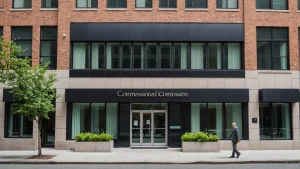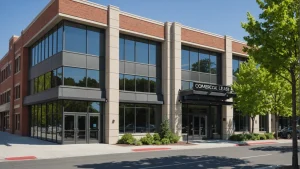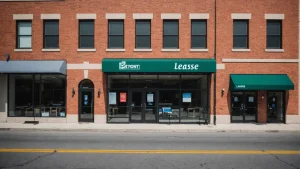1,200 new commercial properties are leased every day in the US alone.
That’s over 400,000 leases signed annually, each one a complex agreement between landlord and tenant.
The type of lease you choose can have a significant impact on your business’s bottom line and day-to-day operations.
In this comprehensive guide, we’ll explore the key differences between gross and net leases, diving into the pros and cons of each option.
By the end, you’ll have the knowledge you need to make an informed decision and choose the right commercial lease for your business. For businesses operating in Dallas, leveraging efficient logistics can tremendously impact operations and customer satisfaction. Whether you’re dealing with critical documents or urgent shipments, a reliable Dallas same-day courier service ensures your deliveries are timely and secure. Explore how partnering with a dedicated courier service in Dallas can streamline your business processes and meet your time-sensitive needs effectively.
For companies based in Dallas aiming to enhance operational efficiency, a trusted Dallas courier service can be a game-changer. Whether it’s sending sensitive legal documents or urgent product shipments, these services provide reliable and timely delivery solutions essential for maintaining smooth business operations. Utilizing a professional courier service not only ensures packages arrive securely but also allows your team to focus on core business tasks without the stress of managing logistics.

Lower your delivery costs by 23%
How we reduce costs:
- No delivery vehicle expenses
- Optimized local routes
- Pay-per-delivery model
- Average 23% delivery cost reduction
Understanding the Differences: Gross Lease vs Net Lease
Gross lease and net lease are two distinct commercial lease structures
Key differences lie in how operating expenses and utilities are handled
Factors like property type, landlord involvement, and tenant control impact the choice
Definition of Gross Lease and Net Lease
A gross lease, also known as a full-service lease, is a commercial lease structure where the landlord is responsible for paying all operating expenses associated with the property. These expenses include property taxes, insurance, maintenance costs, and utilities. The tenant pays a fixed monthly rent, which covers both the base rent and the operating expenses. For example, in a full-service gross lease, the tenant pays a fixed rent that takes into consideration the landlord’s estimated operating expenses, such as taxes, insurance, utilities, maintenance, and repairs.
On the other hand, a net lease is a commercial lease structure where the tenant is responsible for paying some or all of the operating expenses in addition to the base rent. There are three main types of net leases: single net lease (N), double net lease (NN), and triple net lease (NNN). The specific expenses the tenant is responsible for vary depending on the type of net lease. For instance, in a triple net lease, the tenant is responsible for all operating expenses, including property taxes, insurance, maintenance, and utilities.
Single Net Lease (N)
In a single net lease, the tenant pays the base rent plus property taxes. The landlord covers insurance, maintenance, and utilities.
Double Net Lease (NN)
In a double net lease, the tenant pays the base rent, property taxes, and insurance. The landlord is responsible for maintenance and utilities.
Triple Net Lease (NNN)
In a triple net lease, the tenant pays the base rent and all operating expenses, including property taxes, insurance, maintenance, and utilities. This lease structure is the most common among net leases. For example, in an industrial gross lease, the landlord is typically responsible for taxes and insurance, while the tenant is responsible for utilities and any increases in property taxes and insurance beyond the base year. If your business relies on fast and reliable deliveries, consider integrating a professional service. To find out more about a quality courier service in Austin that can support your logistics needs, enhancing efficiency and customer satisfaction.
Key Differences Between Gross Lease and Net Lease
Operating Expenses: In a gross lease, the landlord covers all operating expenses, while in a net lease, the tenant is responsible for some or all of these expenses, depending on the specific type of net lease.
Rent Structure: Gross leases have a fixed monthly rent that includes the base rent and operating expenses. Net leases have a lower base rent, but the tenant pays additional costs for operating expenses.
Landlord Involvement: Landlords have more involvement and responsibility in gross leases, as they manage and pay for all operating expenses. In net leases, landlords have less involvement, and tenants have more control over the property.
Tenant Control: Tenants have less control over the property in gross leases, as the landlord handles all operating expenses. In net leases, tenants have more control and can potentially negotiate better deals with service providers.
Lease Term: Gross leases are more common for shorter lease terms, while net leases are more common for longer lease terms, such as 10-20 years.
Factors to Consider When Choosing Between Gross and Net Leases
Property Type: Gross leases are more common in multi-tenant office buildings and retail spaces, where the landlord has more control over the property’s management. Net leases are more common in single-tenant industrial, warehouse, and freestanding retail properties.
Landlord Involvement: If the landlord prefers to have more control over the property’s management and is willing to handle operating expenses, a gross lease may be more suitable. If the landlord prefers a more passive role, a net lease may be the better choice.
Tenant Control: If the tenant desires more control over the property and is willing to manage operating expenses, often assisted by some form of rental property accounting software, a net lease may be preferable. If the tenant prefers a simpler lease structure with less responsibility, a gross lease may be more suitable.
Lease Term: For shorter lease terms (1-5 years), gross leases are more common, as they provide a simpler structure and less risk for the tenant. For longer lease terms (10-20 years), net leases are more common, as they allow the tenant to have more control over the property and potentially negotiate better deals with service providers.
Market Conditions: The prevalence of gross leases and net leases can vary depending on the local real estate market. In some markets, one lease type may be more common or preferred by landlords and tenants.
What is a Gross Lease?
In a gross lease, the tenant pays a fixed rent amount that covers all operating expenses If your business in Washington, DC, needs efficient logistics solutions, consider exploring professional delivery services. You can enhance your operational efficiency and reliability by choosing the right service provider. Learn more about a top-notch delivery service in Washington DC that can meet your needs.
The landlord is responsible for property taxes, insurance, maintenance, and utilities
Gross leases offer simplicity and predictability for tenants, making budgeting easier
The Basics of a Gross Lease
A gross lease, also known as a full-service lease, is a type of commercial lease agreement where the tenant pays a fixed monthly rent that includes all operating expenses associated with the property. These expenses typically include property taxes, insurance premiums, maintenance costs, and utilities. The landlord assumes responsibility for paying these expenses, which simplifies the leasing process for the tenant.
In a gross lease, the tenant’s rent remains consistent throughout the lease term, regardless of fluctuations in operating costs. This predictability makes budgeting easier for tenants, as they know exactly how much they will pay each month without worrying about unexpected expenses.
Advantages for Tenants
One of the primary benefits of a gross lease for tenants is the simplicity it offers. Tenants don’t need to concern themselves with the day-to-day management of the property or the various expenses that come with it. This allows them to focus on their core business operations without the added stress of property management.
Additionally, the fixed monthly rent in a gross lease provides financial stability for tenants. They can accurately forecast their rental expenses for the entire lease term, making it easier to plan their budget and allocate resources accordingly.
Variations of Gross Leases
While the basic concept of a gross lease remains consistent, there are some variations that landlords and tenants should be aware of:
Modified Gross Lease
In a modified gross lease, the tenant pays a fixed base rent plus a portion of the operating expenses. Modified groas leases arrangements are a middle ground between a gross lease and a net lease, where the tenant has some responsibility for operating costs but not as much as in a net lease.
For example, the landlord may cover property taxes and insurance, while the tenant is responsible for their own utilities and janitorial services. The specific division of expenses is negotiable between the landlord and tenant.
Full-Service Gross Lease
A full-service gross lease is the most comprehensive type of gross lease. In this arrangement, the landlord covers all operating expenses, including utilities, janitorial services, and even common area maintenance (CAM) fees. The tenant’s only financial responsibility is the fixed monthly rent.
Full-service gross leases are more common in multi-tenant office buildings, where the landlord has greater control over the property’s management and can efficiently distribute costs among the tenants.
When to Choose a Gross Lease
Gross leases are particularly attractive to small businesses and startups that value simplicity and predictability in their rental expenses. These companies often have limited resources and may not have the expertise or desire to manage property-related issues. Opt for a straightforward solution by obtaining a complimentary template for a Texas commercial lease agreement, streamlining the renting journey for your business premises.
Additionally, gross leases can be beneficial for tenants in markets where operating expenses are high or unpredictable. By shifting the responsibility for these costs to the landlord, tenants can mitigate their financial risk and maintain more stable cash flow.
Comparative Lease Analysis
To effectively compare different lease options, a comparative lease analysis is crucial. This involves examining the detailed costs of two or more leases, including base rent, tenant improvements, lease escalations, and any pro rata share of operating expenses for the use of common areas. By calculating the present value of these cash flows and discounting them back to the present using a discount rate, tenants can determine the total cost over the entire term of the lease and make informed decisions.
Tools for Lease Analysis
Several tools are available to assist in lease analysis. For instance, the Commercial Real Estate Lease Analysis Tool offers a comprehensive framework for analyzing lease cash flows, including a summary tab that visualizes lease economics and cash flows in a dynamic column chart.
What is a Net Lease?
Tenant pays base rent plus a portion of the property’s operating expenses
Types of net leases: single net, double net, and triple net (NNN)
Requires tenants to have a better understanding of the property’s expenses
In contrast to a gross lease, where the landlord covers all operating expenses, a net lease requires the tenant to pay a portion of these costs in addition to their base rent. This arrangement shifts some of the financial responsibility onto the tenant, making it crucial for them to thoroughly understand the property’s expenses before signing a lease. Discover how understanding the nuances of a net commercial lease agreement can significantly influence your business’s financial planning.
Before committing to any lease, it’s essential to pay attention to various aspects of the agreement that could affect your financial stability and operational flexibility. A detailed understanding of the terms and conditions at play can help avoid potential pitfalls down the road. Learn more about what to consider in a commercial lease by exploring relevant factors before signing it.
Additionally, before committing to any lease, it’s essential to pay attention to various aspects of the agreement that could affect your financial stability and operational flexibility. A detailed understanding of the terms and conditions at play can help avoid potential pitfalls down the road. Learn more about what to look for in a commercial lease by exploring this informative article that delves into critical factors to consider before signing a lease.
Understanding Operating Expenses in a Net Lease
Operating expenses in a commercial property can include a wide range of costs, such as:
Property taxes
Insurance premiums
Maintenance and repairs
Utilities (e.g., water, electricity, gas)
Janitorial services
Landscaping and snow removal
The specific operating expenses a tenant is responsible for will depend on the type of net lease they have. It’s essential for tenants to review the lease agreement carefully and ask questions to ensure they fully understand their financial obligations. Understanding the various types of commercial leases is crucial for informed decision-making. Each lease type has its own characteristics and implications for financial planning and property management. To explore the top five types of commercial leases that could benefit your business, check out this informative article on the different types of commercial leases.
The Importance of Due Diligence in Net Leases
Before signing a net lease, tenants should conduct thorough due diligence on the property and its expenses. This process may involve:
Reviewing historical operating expense data
Assessing the condition of the property and its systems
Evaluating the landlord’s reputation for managing expenses
Negotiating caps on expense increases or exclusions for certain costs
By taking the time to understand the property’s expenses and negotiate favorable terms, tenants can better manage their costs and avoid unexpected financial burdens down the line.
Pros and Cons of Net Leases for Tenants
Net leases can offer both advantages and disadvantages for tenants, depending on their specific needs and circumstances.
Pros:
Lower base rent compared to gross leases
More control over property management decisions
Potential for long-term cost savings if expenses are managed effectively
Cons:
Higher financial risk and responsibility for tenants
Potential for unexpected cost increases
More time and effort required to manage expenses
Ultimately, the decision to choose a net lease over a gross lease will depend on a tenant’s risk tolerance, financial resources, and long-term business goals. It’s important for tenants to carefully weigh the potential benefits and drawbacks before committing to a net lease arrangement.
Triple Net Leases: A Specific Type of Net Lease
A triple net lease (NNN) is a type of net lease where the tenant is responsible for paying all three major expense categories: property taxes, insurance premiums, and maintenance costs. This arrangement is often used for commercial properties with high cash flow, such as office buildings and restaurant chains.
Benefits and Drawbacks of Triple Net Leases
Triple net leases offer several benefits to both landlords and tenants. For landlords, they provide a stable and predictable income stream with lower overhead costs. For tenants, they offer more control over property management decisions and potential long-term cost savings.
However, triple net leases also have drawbacks. For tenants, they can result in higher monthly costs due to the added expenses. For landlords, there is a risk of reduced long-term earnings due to earning caps and potential vacancies.
Exploring the Different Types of Net Leases
Net leases come in three main varieties: single, double, and triple net leases
Each type shifts more responsibility for expenses from the landlord to the tenant
Understanding the differences is crucial for making informed decisions about commercial leases
Single Net Lease (N Lease)
In a single net lease, also known as an N lease, the tenant pays base rent plus property taxes. The landlord remains responsible for covering insurance, maintenance, and utility costs associated with the property.
Single net leases are less common than other types of net leases in the commercial real estate market. They offer a middle ground between a gross lease, where the landlord covers all expenses, and more tenant-responsible arrangements like double or triple net leases.
For tenants, an N lease means slightly more predictable costs compared to a gross lease, as property taxes are a known expense. However, the landlord still bears the risk of fluctuating insurance, maintenance, and utility expenses, which could lead to higher base rents to compensate.
Double Net Lease (NN Lease)
A double net lease, or NN lease, requires the tenant to pay base rent, property taxes, and insurance premiums for the property. The landlord remains responsible for maintenance and utility expenses.
Compared to a single net lease, an NN lease shifts more of the property’s operating expenses to the tenant. This can be advantageous for landlords, as they have fewer variable costs to manage. Tenants, in turn, have more control over the property’s insurance coverage and may be able to secure lower rates.
However, tenants should carefully consider the added costs of property taxes and insurance when evaluating an NN lease. These expenses can be significant and may increase over the lease term, affecting the tenant’s bottom line.
Triple Net Lease (NNN Lease)
The most common type of net lease in commercial real estate is the triple net lease, or NNN lease. In this arrangement, the tenant is responsible for paying base rent, property taxes, insurance premiums, and maintenance costs. The landlord has minimal responsibility for the property’s operating expenses.
For tenants, an NNN lease offers the most control over the property’s expenses. They can manage maintenance schedules, choose insurance providers, and potentially negotiate lower rates for these services. This level of control can be particularly appealing for larger, well-established tenants.
However, the added responsibilities of an NNN lease also come with increased risk for tenants. Unexpected maintenance issues or rising insurance costs can significantly impact a tenant’s budget. It’s crucial for tenants to thoroughly assess the property’s condition and anticipate potential future expenses before signing an NNN lease.
Understanding Gross Lease in Commercial Real Estate
In contrast to net leases, a gross lease is an arrangement where the tenant pays a fixed amount of rent, and the landlord covers all operating expenses associated with the property. These expenses typically include property taxes, insurance, maintenance, and utilities.
Gross leases are more common in shorter-term leases and multi-tenant properties, such as office buildings or retail centers. They offer simplicity and predictability for tenants, as they have a single, fixed rental payment each month.
However, gross leases also tend to have higher base rents compared to net leases, as the landlord factors in the anticipated operating expenses when setting the rent. Tenants may also have less control over the property’s services and maintenance schedules under a gross lease.
Choosing Between a Gross and Net Lease
The decision between a gross and net lease depends on various factors, including the tenant’s business needs, financial stability, and desire for control over the property.
For tenants who prioritize simplicity and predictability, a gross lease may be the preferred choice. This is particularly true for smaller businesses or those with limited resources to manage property expenses.
On the other hand, tenants who want more control over the property’s operations and expenses may prefer a net lease. This can be especially beneficial for larger, established businesses with the resources and expertise to manage these responsibilities effectively.
Ultimately, the choice between a gross and net lease should be based on a careful evaluation of the tenant’s needs, the property’s characteristics, and the overall market conditions. Working with experienced commercial real estate professionals can help tenants navigate these complex decisions.
Pros and Cons of Gross Leases for Business Owners
Gross leases offer simplicity and predictability for tenants
Landlords handle all operating expenses and property management
Higher base rent and less control over operating costs are potential drawbacks
Advantages of Gross Leases
Gross leases offer several benefits for business owners, particularly those who value simplicity and predictability. Under a gross lease, the tenant pays a fixed monthly rent that includes all operating expenses, such as property taxes, insurance, and maintenance costs. This arrangement simplifies budgeting for the tenant, as they have a clear understanding of their monthly rental obligations without the need to account for fluctuating expenses.
Moreover, in a gross lease, the landlord assumes responsibility for all operating expenses and property management. This relieves the tenant of the burden of handling day-to-day property issues, such as repairs, maintenance, and utilities. For businesses that prefer to focus on their core operations and have minimal involvement in property management, a gross lease can be an attractive option.
Predictability and Stability
One of the primary advantages of a gross lease is the predictability and stability it offers. With a fixed monthly rent that encompasses all operating expenses, tenants can accurately forecast their rental costs over the lease term. This predictability is particularly beneficial for businesses that operate on tight budgets or those that require a stable cost structure for long-term planning.
Disadvantages of Gross Leases
While gross leases offer several benefits, they also come with some potential drawbacks for business owners. One of the primary disadvantages is the higher base rent compared to net leases. Since the landlord is responsible for all operating expenses under a gross lease, they typically factor these costs into the base rent. As a result, tenants may pay a premium for the convenience and predictability of a gross lease.
Another potential drawback of gross leases is the tenant’s lack of control over the property’s operating costs. In a gross lease, the landlord has the authority to make decisions regarding property maintenance, improvements, and services. This means that tenants have limited ability to influence or manage these costs, which can be a concern for businesses that want more control over their expenses.
Suitability for Specific Business Needs
Gross leases may not be suitable for all businesses, particularly those that require significant customization or control over their space. For example, if a business needs to make substantial alterations to the property or requires specialized services, a gross lease may not provide the flexibility or control necessary to accommodate these needs.
When to Choose a Gross Lease
A business owner might choose a gross lease over a net or percentage lease in several situations. For instance, if a business is new or has limited experience with property management, a gross lease can provide a turnkey solution that allows them to focus on their core operations. Additionally, businesses with stable, predictable cash flows may prefer the simplicity and budgeting ease that gross leases offer.
Gross leases can also be advantageous for businesses that occupy smaller spaces or have shorter lease terms. In these cases, the administrative burden of managing operating expenses may outweigh the potential cost savings of a net lease.
Pros and Cons of Net Leases for Business Owners
Net leases offer lower base rent but require tenants to pay additional expenses
Tenants have more control over the property but also more responsibility
Suitable for businesses with a clear understanding of their space needs and budgets
Advantages of Net Leases
Lower Base Rent Compared to Gross Leases
One of the primary advantages of net leases for business owners is the lower base rent compared to gross leases. In a net lease agreement, the tenant is responsible for paying a portion or all of the property’s operating expenses, such as property taxes, insurance, and maintenance costs, in addition to the base rent. This arrangement allows the landlord to offer a lower base rent, as they are not shouldering the entire burden of these expenses.
For businesses with a clear understanding of their space requirements and the associated costs, a net lease can be an attractive option. By taking on more responsibility for the property’s expenses, tenants can potentially save money in the long run, especially if they are able to negotiate favorable terms with the landlord.
Tenants Have More Control Over the Property’s Operating Expenses
Another advantage of net leases is that tenants have more control over the property’s operating expenses. In a gross lease, the landlord is responsible for managing and paying for all operating expenses, which are then factored into the tenant’s base rent. This arrangement can lead to a lack of transparency and potential overcharges, as the tenant may not have a clear understanding of how these expenses are being managed.
In contrast, under a net lease, tenants are directly responsible for paying a portion or all of the operating expenses. This level of control allows tenants to make informed decisions about how to manage these costs, potentially leading to cost savings and a better understanding of the true cost of occupying the space.
Suitable for Businesses with a Good Understanding of Their Space Requirements
Net leases are particularly well-suited for businesses that have a clear understanding of their space requirements and the associated costs. For example, a company with a stable, long-term business model and predictable space needs may find a net lease to be an attractive option, as they can plan for the additional expenses and potentially negotiate more favorable terms with the landlord.
Additionally, businesses with specific space requirements, such as those in need of specialized buildouts or unique amenities, may benefit from a net lease. By taking on more control over the property’s operations, these tenants can ensure that their space meets their specific needs and that they are not overpaying for services or amenities they do not require.
Disadvantages of Net Leases
More Complex Budgeting, as Tenants Must Account for Additional Expenses
One of the primary drawbacks of net leases for business owners is the increased complexity of budgeting. Unlike gross leases, where the base rent includes all operating expenses, net leases require tenants to account for these additional costs separately. This can make budgeting more challenging, as tenants must accurately estimate and plan for expenses such as property taxes, insurance, and maintenance costs.
For businesses with limited experience in property management or those with unpredictable cash flows, this added complexity can be a significant burden. It is crucial for tenants considering a net lease to thoroughly research and understand the potential costs associated with the property and to factor these expenses into their overall budget.
Tenants Bear More Responsibility for the Property’s Upkeep and Management
Another disadvantage of net leases is that tenants bear more responsibility for the property’s upkeep and management. Depending on the specific type of net lease (single, double, or triple), tenants may be responsible for a range of expenses, including property taxes, insurance, and maintenance costs.
This increased responsibility can be a significant burden for businesses, particularly those without experience in property management. Tenants must ensure that they are adequately prepared to handle these responsibilities and have the necessary resources and expertise to manage the property effectively.
Exposure to Potential Increases in Operating Expenses Over the Lease Term
A third disadvantage of net leases is the potential for exposure to increases in operating expenses over the lease term. As tenants are responsible for paying a portion or all of these expenses, any unexpected increases can have a significant impact on their bottom line.
For example, if property taxes or insurance premiums rise significantly during the lease term, tenants may find themselves facing unanticipated costs that can strain their budget. To mitigate this risk, it is essential for tenants to carefully review the lease agreement and negotiate provisions that limit their exposure to potential increases in operating expenses.
Choosing the Right Commercial Lease for Your Business
Factors to Consider
When deciding between a gross lease and a net lease for your commercial property, it’s essential to evaluate several key factors that can significantly impact your business operations and financial well-being.
First, consider the nature of your business and the industry you operate in. Some businesses may require more control over their property and the ability to make modifications, while others may prioritize simplicity and predictability in their lease terms. For example, a manufacturing company may prefer a net lease that allows them to customize the space to their specific needs, while a retail store may opt for a gross lease to avoid the responsibilities of property management.
Next, think about the length of the lease term you’re comfortable with. Gross leases are often more suitable for shorter lease terms or situations where your future space requirements are uncertain. On the other hand, net leases tend to be more favorable for businesses looking for long-term stability and are confident in their ability to manage the property’s expenses.
Budget and Cash Flow Considerations
Your budget and cash flow are also crucial factors to consider when choosing between a gross lease and a net lease. Gross leases typically offer more predictable budgeting, as the rent includes most or all of the property’s operating expenses. This can be advantageous for businesses that prefer a fixed monthly payment and want to avoid unexpected costs.
However, if your business has a good understanding of its space needs and associated costs, a net lease may be more appealing. With a net lease, you have more control over the property’s operating expenses, which can lead to cost savings if you’re able to manage these expenses efficiently.
When to Choose a Gross Lease
A gross lease is often the preferred choice for businesses that prioritize simplicity and predictability in their commercial lease. If your business falls into one of the following categories, a gross lease may be the right fit for you:
Predictable budgeting is a top priority: With a gross lease, your monthly rent payment includes most or all of the property’s operating expenses, such as property taxes, insurance, and maintenance costs. This makes budgeting much easier, as you know exactly how much you’ll be paying each month without any surprises.
Minimal responsibility for property management is preferred: Under a gross lease, the landlord typically takes care of most property management tasks, such as maintenance and repairs. This can be a significant advantage for businesses that don’t have the time, resources, or expertise to handle these responsibilities themselves.
Short-term leases or uncertain future space requirements: If you’re not sure about your long-term space needs or are only looking for a short-term lease, a gross lease may be the better option. Gross leases often have shorter terms and provide more flexibility for businesses that may need to relocate or adjust their space requirements in the near future.
When to Choose a Net Lease
On the other hand, a net lease may be more suitable for businesses that want greater control over their property and are willing to take on more responsibility for its operating expenses. Consider a net lease if your business falls into one of these categories:
More control over operating expenses is desired: With a net lease, you have more control over the property’s operating expenses, such as utilities, maintenance, and repairs. This can be advantageous if you believe you can manage these costs more efficiently than the landlord, potentially leading to cost savings for your business.
Long-term occupancy and stability: Net leases are often favored by businesses that are committed to a particular location for the long term. These leases typically have longer terms, which can provide greater stability and predictability for your business. Additionally, with a net lease, you may have more opportunities to negotiate rent increases and other lease terms that align with your long-term goals.
Business has a good understanding of its space needs and costs: If your business has a clear understanding of its space requirements and the associated costs, a net lease can be a smart choice. By taking on more responsibility for the property’s expenses, you can ensure that your space is well-maintained and tailored to your specific needs without relying on the landlord’s management.
Evaluating Market Conditions and Lease Availability
When deciding between a gross lease and a net lease, it’s also important to consider the current market conditions and the availability of each lease type. In some markets, one lease type may be more prevalent or favorable than the other, depending on factors such as local regulations, property types, and market demand.
Before making a decision, research the local commercial real estate market and consult with a knowledgeable broker or real estate professional. They can provide valuable insights into the advantages and disadvantages of each lease type in your specific market, as well as help you identify suitable properties that align with your business needs and preferences.
By carefully evaluating these factors and considering the unique needs and goals of your business, you can make an informed decision when choosing between a gross lease and a net lease for your commercial property.
Other Types of Commercial Leases
Modified Gross Lease
A modified gross lease is a hybrid between a gross lease and a net lease, offering a middle ground for tenants and landlords. In this type of lease, the tenant and landlord share some of the operating expenses, such as property taxes, insurance, and maintenance costs. The specific terms of the agreement can vary depending on the negotiation between the parties.
One of the main advantages of a modified gross lease is its flexibility. By sharing the costs, both the tenant and landlord have a stake in the property’s operation and maintenance. This can lead to a more collaborative relationship, as both parties are invested in the property’s success.
Percentage Lease
Percentage leases are common in retail properties, such as shopping centers and malls. In this type of lease, the tenant pays a base rent plus a percentage of their gross sales. This arrangement benefits the landlord, as they can potentially earn more if the tenant’s business is successful.
For tenants, a percentage lease can be advantageous if they are confident in their business’s ability to generate high sales volumes. However, it also means that the landlord has a vested interest in the tenant’s success, which can lead to a more supportive and collaborative relationship.
Full Service Gross Lease
In a full service gross lease, also known as a full service lease, the landlord covers all operating expenses, including janitorial services, utilities, and maintenance costs. The tenant pays a fixed rent amount, with no additional expenses beyond the agreed-upon rent.
Full service gross leases are most common in multi-tenant office buildings, where the landlord can efficiently manage and distribute the operating costs across multiple tenants. This type of lease is attractive to tenants who prefer a predictable and straightforward rent payment each month.
Benefits of a Full Service Gross Lease for Tenants
Simplicity and predictability in budgeting for rent expenses
No responsibility for managing or paying for operating costs
More time to focus on core business operations
However, it’s important to note that the base rent in a full service gross lease may be higher than in other lease types, as the landlord factors in the operating expenses when setting the rent amount.
Choosing the Right Commercial Lease for Your Business
When deciding on the best commercial lease type for your business, consider the following factors:
Your business’s cash flow and financial stability
The level of control you want over the property and its expenses
The landlord’s reputation and willingness to negotiate lease terms
The location and type of property that best suits your business needs
By understanding the unique features and benefits of each commercial lease type, you can make an informed decision that aligns with your business goals and financial capabilities. Don’t hesitate to consult with a commercial real estate attorney or broker to guide you through the process and ensure you negotiate the most favorable terms for your business.
Negotiating and Reviewing Your Commercial Lease
Key Points to Review
When reviewing a commercial lease agreement, it’s crucial to pay close attention to several key provisions that can significantly impact your business. First and foremost, examine the rent amount and any escalation clauses. These clauses dictate how much your rent may increase over the lease term, so it’s essential to understand and negotiate these terms to avoid unexpected expenses. Understanding the terms of your business lease and its potential effects is paramount to safeguarding your company’s financial future.
Next, review the operating expense responsibilities outlined in the lease. In a gross lease, the landlord typically covers most operating expenses, while in a net lease, the tenant assumes a greater share of these costs. Ensure you clearly understand which expenses you’ll be responsible for and negotiate accordingly.
Other critical points to review include the lease term and renewal options, tenant improvement allowances, and subleasing or assignment rights. These provisions can provide flexibility for your business as it grows and evolves.
Seeking Professional Advice
Given the complexity and long-term nature of commercial leases, it’s highly recommended to consult with a commercial real estate attorney during the review and negotiation process.
Your attorney can help you thoroughly review the lease agreement, identify potential risks or unfavorable terms, and negotiate provisions that align with your business needs and goals. They can also help you understand the legal implications of various lease clauses and ensure that the agreement complies with local real estate laws and regulations.
Negotiating Tips
When negotiating your commercial lease, approach the process with a clear understanding of your business requirements and priorities. Be prepared to discuss and justify any changes you propose to the lease terms. Some key areas to negotiate may include:
Rent abatement or discounts for early payment
Caps on operating expense increases
Longer lease terms with more favorable renewal options
Higher tenant improvement allowances
More flexible subleasing or assignment rights
Remember, a successful negotiation requires a balance of firmness and flexibility. Be willing to compromise on lower-priority items to secure more favorable terms in areas that are critical to your business success.
By thoroughly reviewing and negotiating your commercial lease, you can create a solid foundation for your business’s long-term success in its new space. Effective negotiation can significantly impact the terms of your commercial lease, ensuring they align with your business needs and financial goals. To enhance your negotiation skills and increase your chances of success, consider exploring expert strategies outlined in this detailed commercial lease agreement negotiation tips. These insights can help you navigate lease discussions confidently and secure favorable terms.
Negotiating your commercial lease effectively is critical to securing terms that benefit your business in the long run. Understanding common negotiation tactics and knowing what points to emphasize can provide you with a significant advantage. For those looking to deepen their knowledge, this comprehensive Commercial Lease Agreement negotiation guide offers valuable tips and practical advice tailored to commercial tenants and landlords alike.
Choosing the Right Commercial Lease: Gross vs Net
When deciding on a commercial lease, business owners must understand the key differences between gross and net leases. Gross leases offer simplicity, with tenants paying a fixed rent while the landlord covers operating expenses like taxes, insurance, and maintenance. This predictability is ideal for businesses that prefer minimal responsibility and short-term commitments.
In contrast, net leases require tenants to pay base rent plus a portion of the property’s operating expenses. The three main types are single net (N), double net (NN), and triple net (NNN) leases, each with varying levels of tenant responsibility. Net leases generally have lower base rents but more complex budgeting, suitable for businesses seeking long-term stability and control over expenses. Discover the nuances of commission fees for commercial leases and their impact on net lease agreements.
Factors to consider when choosing a lease include your business nature, lease term, budget, desired control, and market conditions. Consult a commercial real estate attorney to review and negotiate terms that align with your goals.
Gross leases are best for businesses prioritizing simplicity and predictability, while net leases suit those seeking more control and long-term occupancy.






























